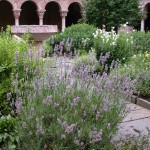Above: Lavandin (Lavandula x intermedia) flowering in Cuxa Garden.
Lavenders in The Middle Ages
Lavender (Lavandula angustifolia ssp. angustifolia) was used to scent linen and to keep moths and insects from woolens, as it still is. According to the fifteenth-century herbal Hortus Sanitatis, or the Garden of Health, this virtue of protecting clothing from vermin endeared lavender to the Mother of God, who also loved the herb as a preserver of chastity: “If the head is sprinkled with lavender water it will make that person chaste so long as he bears it upon him.” (Margaret Freeman, Herbs for the Medieval Household, 1943.)
Lavender had a number of medicinal applications as well as household uses, and could be employed against pains in the heart, fainting spells, and sleeplessness; it was applied to the forehead for headache and included in antidotes, such as a plaster for scorpion bites. It was used internally as well as externally, and a decoction was drunk for epilepsy and kidney ailments and as a preventative for apoplexy. (Frank Anderson, German Book Illustration through 1500: Herbals through 1500, 1983???4.)
Lavenders at The Cloisters
One of the two species of lavender known and used in the Middle Ages, true or English lavender (Lavandula angustifolia ssp. angustifolia) is blooming in Bonnefont Herb Garden. The other medieval species, known as French lavender (Lavandula stoechas) is a tender species that must be grown in pots in our climate. This French lavender begins to flower for us as early as March, and flourishes until June, by which time it has exhausted itself. The English lavender comes into its own as the French lavender goes out of bloom.
We grow yet another lavender that isn’t medieval. The lavandin (Lavandula x intermedia ‘Grosso’) that flourishes in Cuxa Cloister Garden is a hybrid between English lavender and another species, L. latifolia. There are many variations of this cross in wild populations, but ‘Grosso’ is one of the most commonly cultivated forms and is much used in today’s fragrance industry.
The two large bushes of ‘Grosso’ that have grown in Cuxa for some years have blue-violet flowers, but we have just planted a variety sold as ‘Pink Lavandin’. The nursery label identified this, too, as a form of ‘Grosso.’ I don’t think this can be correct, as the authoritative and very comprehensive monograph, The Genus Lavandula, doesn’t list such a form. Does anyone know more about pink-flowered lavandins?
???Deirdre Larkin
Tags: Add new tag, Bonnefont Garden, Cuxa Garden, lavandin, Lavandula, lavenders


July 9, 2008 at 10:32 am
I don’t know about pink-flowered lavandins. But what about Lavandula stoechas L.? I understand that this hardy, shrubby lavender with pinkish/violet flowers was known in Britain before other varieties of Lavandula, and in fact may have been the only variety known in this region before the beginning of the Middle Ages (as Lavandula is curiously missing from the ‘Capitulare de Villis’ of Charlemagne). I understand that lavender was well known in Britain by the 1260s (predating the reintroduction of rosemary), but that its early history is a little fuzzy around the edges.
Would L. stoechas fit into the scheme at the Cloisters as a garden addition, and does anyone know a little more about the early history of Lavender in Britain?
July 9, 2008 at 11:46 am
Excellent blog! Love the pictures. I’ll definitely keep reading.
July 14, 2008 at 11:23 am
Nicole,
We do grow L. stoechas at The Cloisters—in pots, since it is much less hardy for us than L. angustifolia. Albertus Magnus gives its name as ’stycados,’ from the Dioscoridean ’stoichas,’ in reference to the plant’s origins in the Stoechades, a group of islands off the coast of France. It came to be known as ’stickadove’ in English.
Dioscorides asserts that L. stoechas is valuable as an admixture in antidotes, as was L. angustifolia. However, the Herbarius Latinus assigns it medicinal properties distinct from those assigned to L. angustifolia in the Hortus Sanitatis, and recommends L. stoechas to cleanse ulcers and abscesses, as well as noting it???s use as an aphrodisiac in Italy, where it was combined with goat???s milk for the purpose.
The pink-flowering lavandin may turn out to be even more of a mystery than we anticipated, as it is not blooming pink, but blue-violet. It appears to be ‘Grosso’ after all.
August 28, 2008 at 1:59 pm
I am an art teacher with the Orono school district in Minnesota. This year, the focus of our school’s art exploration is the Middle Ages. This is an excellent resource for our studies! Thank you!